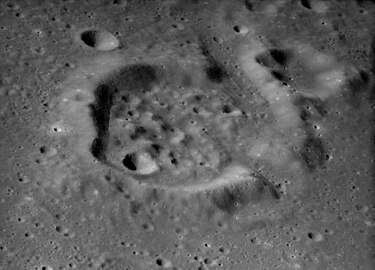
Arzachel is a relatively young lunar impact crater located in the highlands in the south-central part of the visible Moon, close to the zero meridian. It lies to the south of the crater Alphonsus, and together with Ptolemaeus further north the three form a prominent line of craters to the east of Mare Nubium. The smaller Alpetragius lies to the northwest, and Thebit is to the southwest along the edge of the mare.

Fra Mauro is the worn remnant of a walled lunar plain. It is part of the surrounding Fra Mauro formation, being located to the northeast of Mare Cognitum and southeast of Mare Insularum. Attached to the southern rim are the co-joined craters Bonpland and Parry, which intrude into the formation forming inward-bulging walls. The crater is named after Italian geographer Fra Mauro.
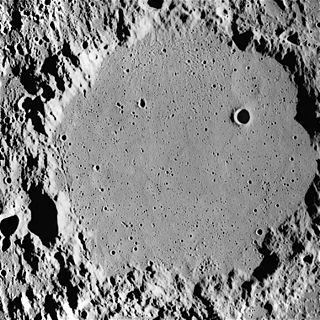
Ptolemaeus is an ancient lunar impact crater close to the center of the near side, named for Claudius Ptolemy, the Greco-Roman writer, mathematician, astronomer, geographer and astrologer. It measures approximately 154 kilometers in diameter.
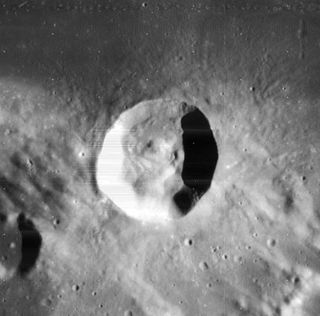
Menelaus is a young lunar impact crater located on the southern shore of Mare Serenitatis near the eastern end of the Montes Hæmus mountain range. Its diameter is 27 km. To the southwest is the small crater Auwers, and to the west-southwest is the even smaller Daubrée. To the northeast is a faint rille system named the Rimae Menelaus.

Zöllner is a lunar impact crater located to the west of Sinus Asperitatis. It was named after German astrophysicist and astronomer Johann Karl Friedrich Zöllner. To the north is the smaller crater Alfraganus and to the northwest lies the oval-shaped Taylor. Southeast of Zöllner is the smaller crater Kant.

Hyginus is a lunar caldera located at the east end of the Sinus Medii. It was named after ancient Roman astronomer Gaius Julius Hyginus. Its rim is split by a 220 kilometer-long rille, Rima Hyginus, that branches to the northwest and to the east-southeast. The crater is deeper than the rille, and lies at intersection of the rille's branches. Together, the crater and the rille form a prominent feature in an otherwise flat surface. Smaller craters along the length of the rille may have been caused by the collapse of an underlying structure.

Petavius is a large lunar impact crater located to the southeast of the Mare Fecunditatis, near the southeastern lunar limb. Attached to the northwest rim is the smaller crater Wrottesley. To the southeast are Palitzsch, Vallis Palitzsch, and Hase. Farther to the north is the large crater Vendelinus. Petavius appears oblong when viewed from the Earth due to foreshortening. Petavius is Imbrian in age.

Carrel is a small lunar crater on the Mare Tranquillitatis. It has a somewhat distorted appearance, having a slight protruding bulge in the northwest rim. The interior is somewhat irregular, with ridges and some slumped material. This crater lies across a ridge in the surface of the mare.

Taruntius is a lunar impact crater on the northwestern edge of Mare Fecunditatis. It was named after ancient Roman philosopher, mathematician and astrologer Lucius Tarutius Firmanus. To the northwest is the lava-flooded crater Lawrence, and to the north lie the craters Watts and da Vinci.
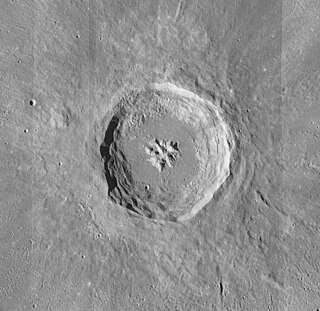
Aristillus is a prominent lunar impact crater that lies in the eastern Mare Imbrium. It was named after Greek astronomer Aristyllus. Directly to the south is the smaller crater Autolycus, while to the southwest is the large Archimedes. To the northeast are the craters Theaetetus and Cassini.

Descartes is a heavily worn lunar impact crater that is located in the rugged south-central highlands of the Moon. To the southwest is the crater Abulfeda. It is named after the French philosopher, mathematician and physicist René Descartes.

Gambart is a small lunar impact crater on the Mare Insularum, near the central region of the Moon. It is named after French astronomer Jean-Félix Adolphe Gambart. It can be located to the south-southeast of the prominent ray crater Copernicus. In the past, the floor of Gambart has been flooded with lava, leaving a relatively flat surface surrounded by a smooth but somewhat polygon-shaped outer rim. To the southwest of Gambart is an area of hilly terrain deposited from ejecta during the Mare Imbrium impact, known as the Fra Mauro Formation.

Julius Caesar is a lava-flooded lunar impact crater with a low, irregular, and heavily worn wall. Its diameter is 85 km. It was named after Roman statesman Julius Caesar. It is located to the west of Mare Tranquillitatis, and directly southeast of the crater Manilius on the Mare Vaporum. To the east is the rounded Sosigenes.

Pytheas is a small lunar impact crater located on the southern part of the Mare Imbrium, to the south of the crater Lambert. It was named after ancient Greek navigator and geographer Pytheas of Massalia.

Alfraganus is a small lunar impact crater that lies in the rugged highland region to the southwest of the Mare Tranquillitatis. It is named after Persian astronomer Alfraganus. Northwest of Alfraganus is the crater Delambre, and to the south is the irregular Zöllner. The rim of Alfraganus is circular and retains a sharp edge that has not received a significant amount of wear due to subsequent impacts. The interior floor is roughly half the diameter of the crater rim.
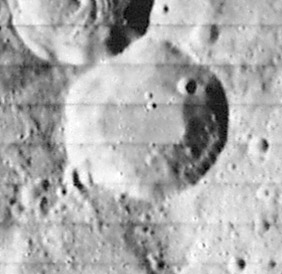
Azophi is a lunar impact crater that lies in the rugged south-central highlands of the Moon. The crater is named after the 10th-century Persian astronomer Abd Al-Rahman Al Sufi, also known by his western name, Azophi. The northwest rim is attached to the slightly smaller crater Abenezra, to the east-southeast is the large and irregular Sacrobosco, and to the west-southwest is Playfair.

King is a prominent lunar impact crater that is located on the far side of the Moon, and can not be viewed directly from Earth. The crater was named after Arthur Scott King and Edward Skinner King in 1970. Prior to that, this crater was known as Crater 211. It forms a pair with Ibn Firnas, which is only slightly larger and is attached to the northeast rim of King. To the northwest is the crater Lobachevskiy, and Guyot is located an equal distance to the north-northwest.

Davy is a small lunar impact crater that is located on the eastern edge of the Mare Nubium. It was named after British physicist Humphry Davy. It overlies the lava-flooded remains of the satellite crater Davy Y to the east, a formation which contains a crater chain designated Catena Davy. To the southeast of Davy is the prominent crater Alphonsus.

Firsov is a lunar impact crater on the far side of the Moon. It is located to due south of the crater Lobachevskiy, and to the northwest of Abul Wáfa. The circular rim of this crater has a small outward bulge along the southern edge, and smaller bulges along the western side. The inner walls have slumped to form talus piles along the base. The low-albedo interior floor is nearly level and featureless.

Sklodowska (Skłodowska) is a large lunar impact crater that is located on the far side of the Moon. It lies just past the southeastern limb, and can sometimes be viewed from Earth under favorable conditions of libration and illumination. The crater is located to the northeast of the older walled plain Curie, and to the southwest of Pasteur, another walled plain.


